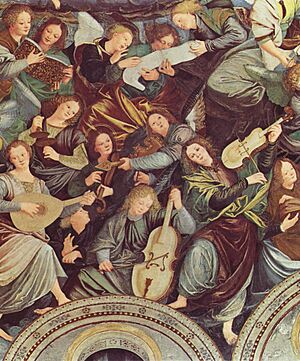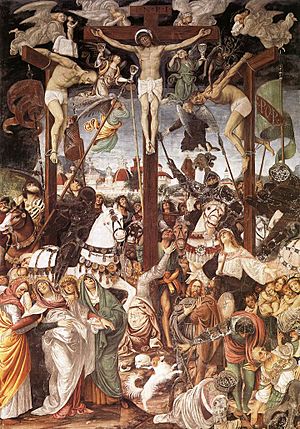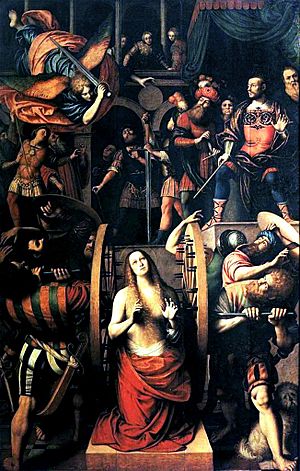Gaudenzio Ferrari facts for kids
Gaudenzio Ferrari (around 1471 – January 11, 1546) was a famous Italian painter and sculptor. He lived during the Renaissance, a time when art and learning were very important.
About Gaudenzio Ferrari
Gaudenzio Ferrari was born in a small town called Valduggia in Italy. This area is now part of Piedmont. He first learned to paint in Vercelli from an artist named Gerolamo Giovenone.
Later, he moved to Milan to continue his studies. He learned at a school linked to the Milan Cathedral. Around 1504, he traveled to Florence, another important art city. Gaudenzio Ferrari passed away in Milan.
His Art Style
Gaudenzio Ferrari's early paintings were influenced by the art school in Milan. This school was inspired by the famous artist Leonardo da Vinci. However, Gaudenzio also had his own unique style. His art often showed strong feelings and emotions.
One of his most famous projects is at the Sacro Monte di Varallo. This is a special place on a hilltop with many chapels. These chapels are like a mix of a diorama and a wax museum. They have life-sized figures made of terracotta, which is a type of clay.
By 1513, Gaudenzio had painted scenes from the life of Christ. He did this in a large wall painting, called a fresco, at Santa Maria delle Grazie in Varallo Sesia. He returned to work on the chapels at Sacro Monte di Varallo around 1524.
His most well-known work there is a fresco of the Crucifixion. This painting has many figures, and some are even sculpted in 3D. The ceiling above shows angels crying.
Gaudenzio also created amazing art in other places. He painted a large group of angels in the dome of the Santa Maria dei Miracoli church in Saronno. Another important painting is his fresco of St Anne. This painting shows how he combined the realistic style of Milan with the colorful style of Venice.
Gaudenzio Ferrari was a very busy painter. He was known for making his art feel lively and full of movement. Most of his paintings were about religious topics. Some of his main students included Andrea Solario and Gian Paolo Lomazzo.
Important Works
Here are some of Gaudenzio Ferrari's important artworks:
- Sant'Anna Altarpiece (found in Galleria Sabauda and National Gallery, London)
- Pietà (in the Royal Gallery, Turin)
- St Catharine Miraculously Saved from the Torture of the Wheel (at the Brera Gallery, Milan)
- Frescoes in the church of Santa Maria della Pace, Milan
- Virgin with Angels and Saints under an Orange Tree (in the Cathedral, Vercelli)
- Last Supper (in the Refectory of San Paolo)
- Birth of the Virgin, Annunciation, Visitation, Adoration of the Shepherds and Kings, Crucifixion, Assumption of the Virgin (painted between 1532–1535, in the Church of San Cristoforo)
- St Paul Meditating (at the Louvre Museum, Paris)
- Presentation in the Temple, Christ among the Doctors, History of Christ (painted in 1507, in the Convent of the Minorites, Varallo)
- Adoration (painted after 1527, in Santa Maria di Loreto, near Varallo)
- Glory of Angels (painted in 1535, in the Dome of the Santa Maria dei Miracoli, Saronno)
- Scourging of Christ, Ecce Homo and Crucifixion (painted in 1542, in Santa Maria delle Grazie, Milan)
See also
 In Spanish: Gaudenzio Ferrari para niños
In Spanish: Gaudenzio Ferrari para niños




